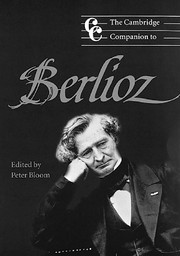Book contents
- Frontmatter
- Introduction: Berlioz on the eve of the bicentenary
- Part I Perspectives
- Part II Principal compositions
- 3 Genre in Berlioz
- 4 The symphonies
- 5 The concert overtures
- 6 The operas and the dramatic legend
- 7 The religious works
- 8 The songs
- Part III Major writings
- Part IV Execution
- Part V Critical encounters
- Part VI Renown
- Notes
- Bibliography
- Index
3 - Genre in Berlioz
from Part II - Principal compositions
Published online by Cambridge University Press: 28 September 2011
- Frontmatter
- Introduction: Berlioz on the eve of the bicentenary
- Part I Perspectives
- Part II Principal compositions
- 3 Genre in Berlioz
- 4 The symphonies
- 5 The concert overtures
- 6 The operas and the dramatic legend
- 7 The religious works
- 8 The songs
- Part III Major writings
- Part IV Execution
- Part V Critical encounters
- Part VI Renown
- Notes
- Bibliography
- Index
Summary
Titles, cycles, collections
On the face of it, Berlioz is a composer for whom genre was a secondary issue. Working within a genre creates definite expectations, but Berlioz – unlike Monpou and Niedermeyer in their romances, Haydn and even Beethoven in their symphonies, Auber and Meyerbeer in their operas – seems to have preferred not to operate in this way. Berlioz's overtures, among his most popular and readily understood works, do adhere to expected outlines, but his symphonies evoke the theatre, his operas pay only nominal tribute to established categories, and his liturgical compositions (the Messe solennelle, Requiem, and Te Deum) present generically conventional surfaces which prove, on closer examination, to be deceptive.
Berlioz implicitly acknowledged a difficulty by providing generic subtitles for otherwise purely descriptive titles. At the time of their composition, the Épisode de la vie d'un artiste, Harold en Italie, Roméo et Juliette, La Damnation de Faust, and L'Enfance du Christ were the sole occupants of their generic categories – respectively Fantastic Symphony (Symphonie fantastique en cinq parties), Symphony in Four Movements with a Solo Viola (Symphonie en quatre parties avec un alto principal), Dramatic Symphony (Symphonie dramatique), Dramatic Legend (Légende dramatique), and Sacred Trilogy (Trilogie sacrée). Despite such specificity, however, Berlioz could not always avoid misunderstanding. If the subtitle for Harold en Italie tells us that in this symphony there is more than a trace of the concerto, terms such as “dramatic legend” convey little about genre: some contemporaries mistakenly alluded to the Damnation as a symphony, for example, but Berlioz would not accept the designation “Symphonic legend.”
- Type
- Chapter
- Information
- The Cambridge Companion to Berlioz , pp. 39 - 52Publisher: Cambridge University PressPrint publication year: 2000

